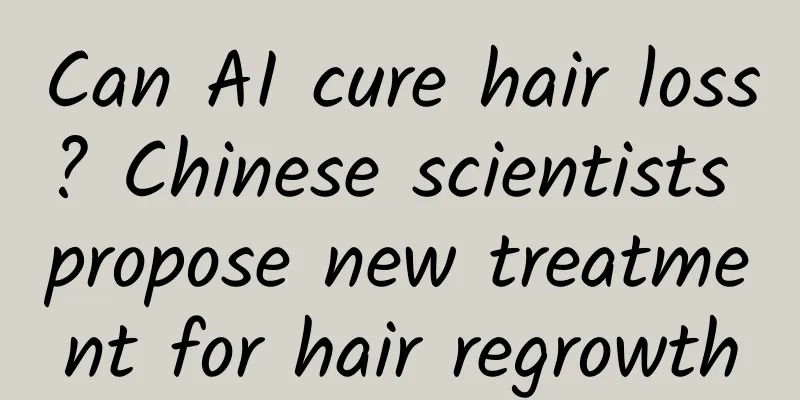Can AI cure hair loss? Chinese scientists propose new treatment for hair regrowth

|
Nowadays, hair loss has become a headache for contemporary young people. Due to the fast pace of daily work and life, high pressure, and irregular work and rest habits, hair loss, baldness, and high hairline have gradually become younger. Regardless of age, hair loss is a very distressing thing for anyone, as a person's hairstyle is often related to their level of self-confidence. Faced with the embarrassing situation of "sudden baldness", some people choose to accept the reality of baldness, while others hope to regain a full head of black hair. Nowadays, artificial intelligence (AI) technology may become a good helper for people to get rid of the trouble of hair loss. Recently, with the help of AI, the team of Associate Professor Wang Lina from the School of Environmental and Safety Engineering of Qingdao University of Science and Technology, the team of Associate Professor Zhu Zhiling from the School of Materials Science and Engineering and their collaborators designed a nanozyme with better performance and constructed a proof-of-concept microneedle patch, which effectively achieved hair regeneration in mice . The related research paper, titled "Machine Learning Guided Discovery of Superoxide Dismutase Nanozymes for Androgenetic Alopecia", has been published in the scientific journal Nano Letters. Currently, most people with severe hair loss suffer from androgenetic alopecia, a type of hair loss that affects both men and women and is caused by genetic factors and the effects of androgens. Testosterone is a common and important androgen, secreted by the male testicles or female ovaries, and a small amount by the adrenal glands. Once it reaches the hair follicles, it is converted into dihydrotestosterone (DHT), another androgen that is considered a major culprit of hair loss. It can cause hair follicles to shrink and hair to become thinner. For women, although estrogen in the body can inhibit androgen, if the hormone balance in the body is broken or estrogen decreases after middle age, hair loss will occur due to excessive androgen. In this case, the paper describes, hair follicles become damaged by androgens, inflammation, or excess reactive oxygen species, such as oxygen free radicals. When levels of oxygen free radicals are too high, they overwhelm the body's antioxidant enzymes that normally keep them in check. Superoxide dismutase (SOD) is one of the antioxidant enzymes. Scientists have also created an analog based on this enzyme, namely nanozymes, but they do not perform well in removing oxygen free radicals. Therefore, the research team tried to explore whether artificial intelligence could help them design a nanozyme that could better treat hair loss. In this work, they selected transition metal thiophosphites as potential nanozyme candidates and tested the machine learning model using 91 different combinations of transition metals, phosphates, and sulfates. Figure | AI guided the discovery of SOD-like nanozymes. (Source: This paper) The prediction results showed that MnPS3 would have the most powerful SOD-like ability. They then synthesized MnPS3 nanosheets through chemical vapor transport of manganese, red phosphorus and sulfur powder. In preliminary tests on human skin fibroblasts, the nanosheets significantly reduced the levels of reactive oxygen species without causing harm. Figure|MnPS3-like SOD activity. (Source: This paper) Based on these results, they created MnPS3 microneedle patches and used them to treat a mouse model affected by androgenic alopecia. Within 13 days, the mice regenerated thicker hair compared to mice treated with testosterone or minoxidil. The researchers say their study both suggests a new nanozyme therapy for hair regeneration and demonstrates the potential of computer-based approaches in designing future nanozyme therapies. In addition, previous studies have confirmed that scientists can use genetic engineering to reprogram cells, converting ordinary cells (such as blood or fat cells) directly into hair stem cells to treat hair loss. Although science and technology can help people grow "lost" hair again, perhaps the simplest and most effective treatment is internal self-regulation, actively adjusting your mindset, ensuring adequate sleep, eating a balanced diet, quitting smoking, combing your hair frequently, etc. Finally, I hope everyone can stay away from hair loss, baldness and a higher hairline. Reference Links: https://pubs.acs.org/doi/full/10.1021/acs.nanolett.2c03119 https://ha.qust.edu.cn/info/1013/1513.htm https://cl.qust.edu.cn/info/1246/3534.htm |
<<: How come cockroaches, which have been "extinct" for more than 80 years, reappeared? !
>>: Was our moon "spitted out" by the earth?
Recommend
How to learn Chinese medicine by yourself
Traditional Chinese medicine is the medicine of u...
What are the medicinal effects of Chinese yam, honeysuckle and licorice?
Smilax glabra, honeysuckle and licorice all have ...
The efficacy and function of hollyhock flowers
The development of Western medicine has brought s...
Chicory root benefits and effects
Many Chinese medicines have particularly obvious ...
Are Rehmannia glutinosa and Radix Rehmanniae the same?
Are cooked rehmannia and cooked rehmannia root th...
The efficacy and function of Niu Mao Qi
The nutritional value of Gastrodia elata is rich ...
The role and efficacy of Cordyceps sinensis
What are the functions and effects of Cordyceps s...
The efficacy and function of Tongguanteng
Many people think that the textbooks are all simi...
The efficacy and function of nut
The sugar nut is a very nutritious and precious m...
Benefits of Geranium Essential Oil
Geranium essential oil is a common health product...
The efficacy and function of Castanopsis chinensis
Castanopsis chinensis is a kind of traditional Ch...
World Book Day | Middle school students talk to academicians, writers, aerospace experts... to solve the "confusion" of reading
General Secretary Xi Jinping sent a congratulator...
What are the benefits of drinking wolfberry soaked in water?
Many people have not tried to drink wolfberry soa...
The "Fujian" is here! my country's third aircraft carrier is launched and named (with on-site video)
The launching and naming ceremony of my country&#...









